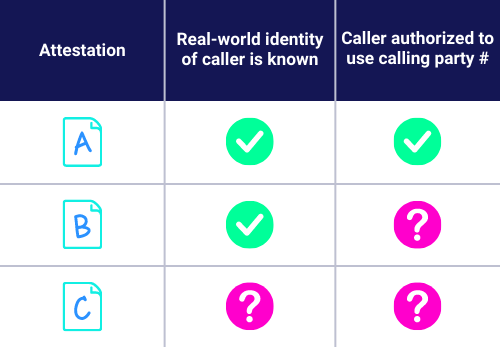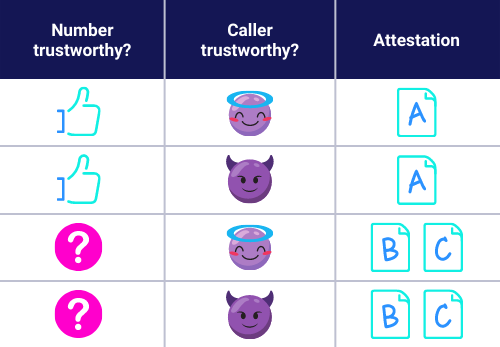Many enterprises and other organizations have difficulty reaching their customers, prospects, and other contacts, due to the growing rate of robocalls that have left many consumers reluctant to answer any call from an unrecognized number. Terminating voice networks use analytics platforms to identify suspicious calling patterns and tag them as spam, fraud, and more. Unfortunately, those platforms can also mark legitimate calls incorrectly, causing the call to be blocked in the network. Even when the numbers aren’t outright blocked, they can be presented to the consumer with a scam or spam warning.
Enterprises are upset and mystified that mis-tagging is occurring, especially if they are aware of FCC requirements and industry news surrounding STIR/SHAKEN. Press releases and news stories touted the STIR/SHAKEN implementation deadline of June 30, 2021, as the beginning of the end for robocallers. Unfortunately, June 30 has come and gone, and legitimate calls are still being mis-tagged. Even if STIR/SHAKEN hasn’t been sufficient to stop the robocallers, shouldn’t it at least stop the mis-tagging of legitimate calls? Regrettably, no. In fact, STIR/SHAKEN wasn’t intended to replace the analytic platforms and AI (artificial intelligence) algorithms that tag suspicious–and sometimes legitimate–calls. So, why doesn’t STIR/SHAKEN prevent legitimate calls from inaccurate spam tagging?
1. STIR/SHAKEN indicates whether the calling party number is “trustworthy” or “possibly trustworthy”. STIR/SHAKEN does not assess whether the number is blatantly “untrustworthy”.
STIR/SHAKEN uses letter grades A, B, and C to indicate the level of trust the originating or transit network has in the calling party number. These trust levels are Full Attestation (A), Partial Attestation (B), and Gateway Attestation (C). A attestation means the voice service provider knows that the customer originating the call is authorized to use the calling party number. The other attestation levels mean the service provider has less information about the customer and the calling party number. B and C attestation do not indicate untrustworthiness. Frequently, calls receive B or C attestation even when the calling party number is used legally and properly (e.g., an enterprise who uses multiple providers for route diversity or least cost routing will get B attestation when they route their legitimate number through the alternate providers).

2. STIR/SHAKEN indicates whether the calling party number is trustworthy, not whether the call itself is trustworthy.
The STIR/SHAKEN attestations relate to the calling party number, helping to demonstrate if the caller is permitted to use this calling party number. STIR/SHAKEN does not assess whether the caller or the call itself is trustworthy. Assessing caller trustworthiness is managed by analytic platforms, which conduct risk assessments on the call itself.
Callers who steal or impersonate calling party numbers should not be trusted; we also need to fear scammers and spammers who use their own phone numbers. Even if the phone number is real and trustworthy (and has “A” attestation!), the call may be made by a scammer or spammer and might not be safe. The analytic platforms need to go beyond STIR/SHAKEN to make this assessment.

3. Spam calls are unwanted, annoying, and legal.
That’s right, many of these nuisance calls are legal! STIR/SHAKEN was motivated by the unlawful use of spoofed phone numbers. Similarly, the FCC authorizes networks to block unlawful traffic. That still leaves many legal, unwanted calls being delivered to consumers. For example, if telemarketers respect the Do Not Call Registry, consent and opt-out rules, and other FCC and FTC regulations, then their mass calling campaigns are not unlawful. Analytic platforms try to protect consumers from these calls with labels like “spam”. In addition, the analytic platforms often cannot make real-time distinctions between unlawful vs. unwanted calls. If it is not obvious the call is fraudulent, then the call will be marked as “spam.” STIR/SHAKEN is of limited value for this purpose.
4. STIR/SHAKEN is not ubiquitous.
The June 2021 STIR/SHAKEN deadline did not apply to the entirety of the voice network. It applied only to domestic calls routed entirely over SIP connections.
- Many networks still use non-SIP SS7 signaling. If the originating network transmits a STIR/SHAKEN “A” attestation, the STIR/SHAKEN information will be completely dropped (or possibly dropped and regenerated as a “C in transit) if the call encounters an SS7 leg in the call path.
- International calls are not required to implement STIR/SHAKEN. (Much of the fraudulent use of USA phone numbers originates overseas.)
- Some SIP-based service providers have extensions from the FCC and have not yet implemented STIR/SHAKEN.
Do you want to learn more about modernizing your contact center and accelerating customer engagement with generative AI and automation? Schedule an AI and automation Customer Interaction Intent Study with IntelePeer now.
5. STIR/SHAKEN is one of many factors.
As described above, legitimate calls may arrive at the terminating network with STIR/SHAKEN A, B, or C attestation, or with no STIR/SHAKEN at all. The same is true for illegitimate calls. Thus, call analytic platforms cannot use STIR/SHAKEN by itself to distinguish suspicious vs. legitimate traffic. (In fact, we’ve seen cases where the originating network assigned A attestation, but the terminating networks still mislabeled the call as spam.)
Instead, STIR/SHAKEN becomes one more factor the analytic platforms can use in conjunction with their other data when evaluating traffic. For example, if the other factors are indecisive, then a STIR/SHAKEN “A” can tip the scales in favor of the call being trusted. But if the other factors are negative, then a STIR/SHAKEN “A” probably won’t be sufficient to counteract spam tagging. Similarly, if there are no other negative factors, then a STIR/SHAKEN “C” or no STIR/SHAKEN at all would not result in spam tagging.
Reputation management to the rescue
If STIR/SHAKEN is not the magic wand to prevent spam and fraud mis-tagging, what is? IntelePeer offers Reputation management services specifically to help legitimate enterprises avoid this problem. These services allow you to prevent, monitor, and correct mis-tagging.
Contact us today to learn more about our Reputation Management solution and how it can improve customer experience, modernize communications, and streamline operations.
